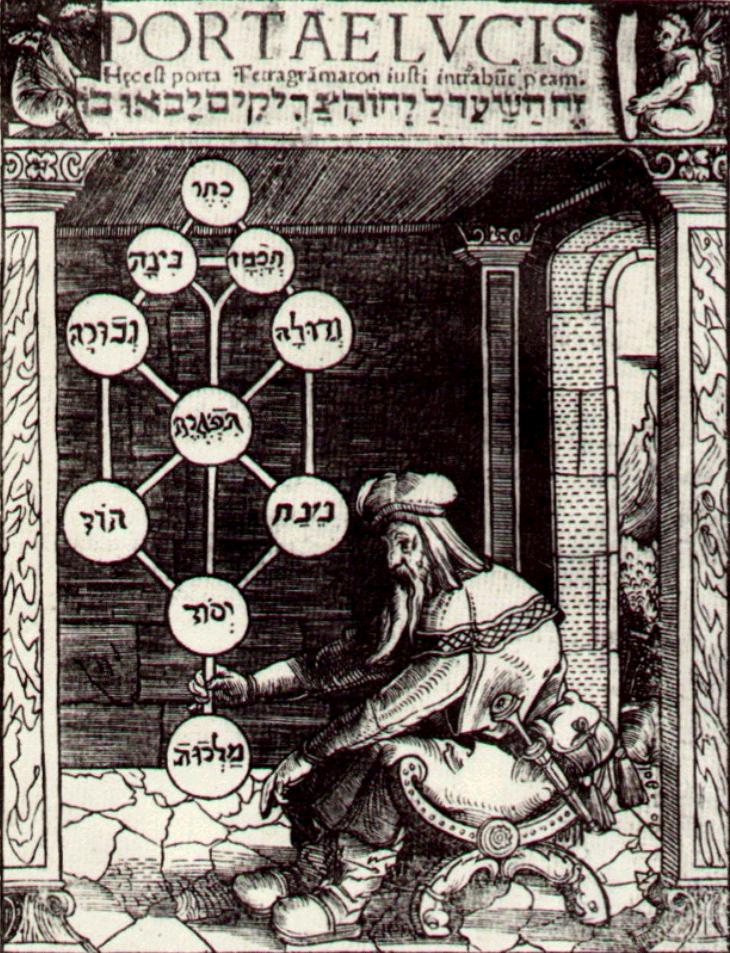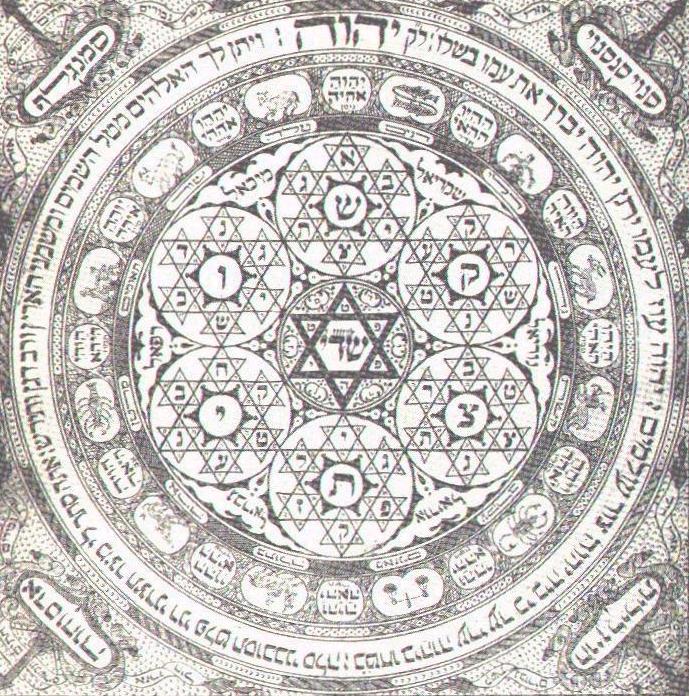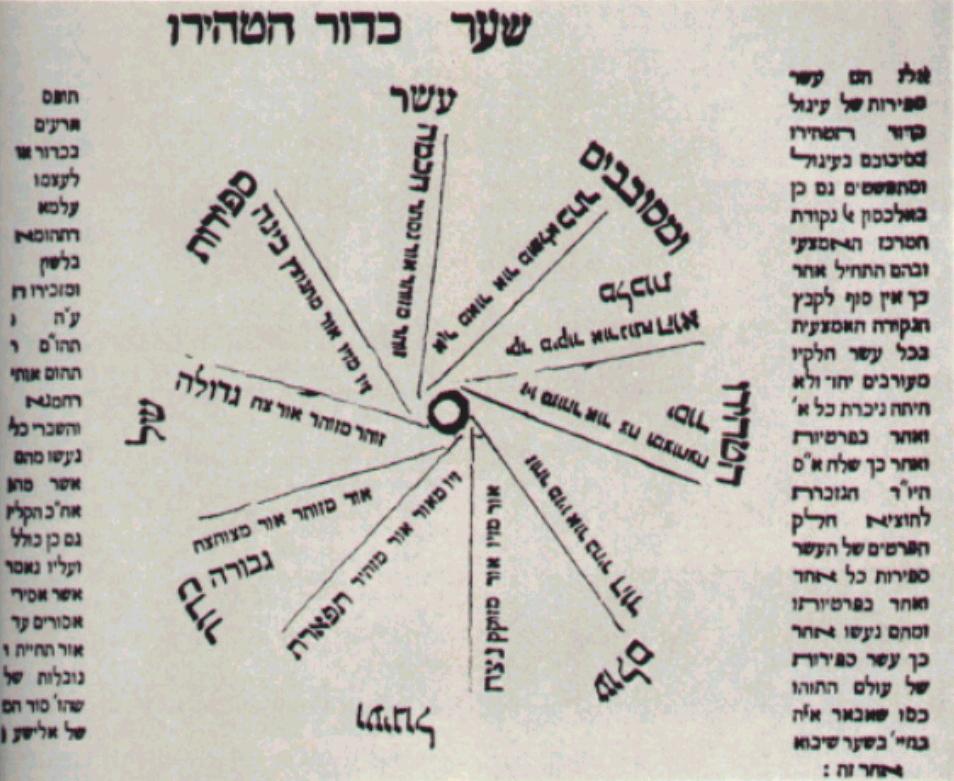
|
|
The
Theosophical Kabbalah
The Lurianic Kabbalah Rabbi Isaac Luria (1534-72), was perhaps
the most visionary and original of the theosophical Kabbalists. Luria offered
novel insights into and interpretations of the classic Kabbalistic text, the Zohar, and his myth of creation,
deconstruction and restoration became a dominant motif throughout later
Kabbalistic and Hasidic thought. Luria's theosophical system serves as an
important foundation for the New Kabbalah, i.e. for a Kabbalistic approach to
contemporary theology, philosophy and psychology. On this page, Luria's theosophy is
described in outline form, with links connecting the reader to fuller
descriptions and interpretations of the major Kabbalistic symbols, as well as
to matters of comparative interest. Readers interested in more detailed
discussions of these topics are referred to the "Books" and
"Articles" links on this website. When it arose within Ein-sof (the Infinite) to weave Yesh (Something) from its Ayin (Nothing) Ein-sof performed an act of Tzimtzum,
contracting and concealing itself from a point, thereby forming a central, metaphysical
void. It is in this void that the Primordial Man, Adam Kadmon, and all the countless
Worlds(Olamot)
emerge. Lights flashing and recoiling from the
eyes, nose, mouth and ears of the Primordial Man emanate the ten archetypal
values, the Sefirot
and the 22 holy letters (Otiyot Yesod), which were to be the
building blocks of the universe and the structural elements of all things. These lights first formed vessels (Kelim) that were to contain the further
emanations of the light of the infinite (Or
Ein-sof). However, the vessels could not contain these
emanations, and in a cosmic catastrophe known as the Breaking of the Vessels (Shevirat ha-Kelim),
the vessels were displaced and shattered. The letters, which had been
initially assembled into meaningful groups became a The broken vessels tumbled down through
the metaphysical void, trapping within themselves sparks of the emanated
divine light. These entrapped sparks became shrouded in layers of darkness as
they fell into the Sitra Achra,
the "Other Side." The world, instead of being composed of the
pristine archetypal values of Wisdom, Understanding, Knowledge, Love,
Judgment, Beauty, etc. was now formed of the broken, displaced, and obscured
lights and vessels as they coalesced as Kellipot (Husks, complexes). As a
result, our world (Assiyah-"making"),
is, as Adin Steinsaltz has put it, "the worst of all possible worlds in
which there is still hope," yet paradoxically it is the best of all
possible worlds because it serves as the arena for redemption (see "The Mystic As Philosopher"). As a result of the Breaking of the
Vessels, the Primordial Adam was himself partly shattered into a multitude of
individual souls, who themselves are comprised of the same fragments or Kellipot that form our world, and which
are exiled and alienated in the "Other Side.". The task of
individual men and women is to extract (via an act of birur) those sparks (netzotzim) that are his or her fortune
to encounter in life, and to raise and spiritualize them, so as to
reconstitute the Sefirot and
the figure of the Primordial Man as five Partzufim (Visages or Personalities
of God) and restore the harmony of the opposites, as well as the conjugal
relations between the masculine and feminine aspects of God, man and the
world.
The Kabbalah and other Traditions Many of the ideas and themes of the
Lurianic Kabbalah are also present in systems of thought (Indian philosophy, Platonism,
Gnosticism) that, according to many scholars,
antedate the Kabbalah, and (at least in the case of Platonism and Gnosticism
two) seem to have impacted upon the development of Jewish mysticism. The
Kabbalah, however, is unique in its position in the history of western
thought, acting as it were as a "switching station" in which the
biblical tradition, oriental mysticism and western philosophy converge. In
the Kabbalah of Isaac Luria these traditions combine with Luria's profound
spiritual insight and intense mythical imagination to produce a comprehensive
philosophical and psychological vision of the nature of God and humankind
that was only imperfectly represented in the prior traditions. Of equal significance, however, is the
relationship between the Kabbalah and more modern systems of thought and
practice. The Kabbalists had a profound impact upon such Christian mystics as
Jakob Boehme, and through them, on the German romantic philosophers,
Schelling and Hegel. The basic metaphors of the
Lurianic Kabbalah are psychologized in Freud, and Jung. Jung, whose psychology is in large part derived
from a meditation on the spiritual aspects of alchemy, was greatly influenced
by the Kabbalah, and can be said to have extracted the Kabbalistic
"gold" that lay buried in the alchemist's arcane formulae for the
transmutation of metals. Finally, Jacques Derrida, the founder of
deconstruction, explores many themes that are quite reminiscent of
Kabbalistic ideas. These include Derrida's notions of "difference"
and the "trace," which have much in common with, and are llluminative
of, the Lurianic symbols of Ein-sof
and Tzimtzum, as well as the
notion of "deconstruction" itself, which can be understood as a
contemporary interpretation of the Lurianic "Breaking of the
Vessels." While a study of the Kabbalah can provide rich
insights in both ancient and modern philosophy, the opposite is true as well.
Looked at through the lens of comparative studies in philosophy, psychology
and religion, the symbols of the Kabbalah take on a deeper and more profound
significance for our time. This process is already transforming an ancient
spiritual treasure into a modern, and post-modern, approach to philosophy,
psychology and theology: the foundation for a New Kabbalah, suited to our
time. The rapidly growing interest in the
Kabbalah in recent years, amongst Jewsand non-Jews alike, suggests that the
message of the New Kabbalah is an ecumenical and multi-cultural one. Without
in any way detracting from the importance of maintaining the Kabbalah's
Jewish roots and identity, we can note that interest in the Kabbalah amongst
non-Jews is a centuries old affair. We are only beginning to understand the
significance and impact of the so-called "Christian Kabbalah" on
the history and development of western thought. More importantly it is a fundamental axiom
of Kabbalistic and Hasidic metaphysics that the world should be
differentiated in all its plurality, so as to achieve the greatest possible
variety and detail in the expression of the divine sefirotic values. which
are only then to be reunited in a single source. The New Kabbalah celebrates
the world's and humanity's diversity, but also recognizes both the underlying
unity and need to achieve the actual unity of all people and things. Tikkun ha-Olam The Kabbalah, in both its old and new incarnation
is a profound spiritual and intellectual discipline. Yet, as the Hasidim have
long recognized, it is nothing, unless it is a discipline that informs one's
practical life. Kabbalistic practice is embodied in the notion of Tikkun ha-Olam,
literally the "repair" or "restoration" of the world. The
Hasidic doctrine of Tikkun
holds that a person's soul exists in sympathy with the people and objects
inhis environment, in such a manner that each moment in a person's life
presents an opportunity to "raise the sparks" that only he or she
can redeem. The people and objects a man encounters in the course of his
lifetime are presented to him precisely in order that he can liberate the
spiritualenergy within them and, in so doing, also liberate the sparks within
his own soul. How is this to be However, one need not participate in a
traditional Jewish lifestyle in orderto effect Tikkun. The mitzvah, for example, of tzedakah (charity) is available to all,
at any time. Further, nearly any act can be done in the spirit of either
promoting or forestalling the world's ultimate redemption. The greeting we
give (or don't) give our neighbor, the malicious gossip we refrain (or don't
refrain) from speaking, the patience we show (or don't show) to our parents,
husbands, wives, children, colleagues, and strangers, are all part of the Tikkun equation. The New Kabbalah holds that any act which
furthers the values of the Sefirot,
the value archetypes through which the world was created; any act that brings
knowledge, wisdom, understanding, love, justice, compassion, beauty, etc.
into the world is an act of Tikkun,
and fulfills the purpose of creation and contributes to the repair and
restoration of both ourselves and the world. The Lurianic Kabbalah is treated in detail
in Sanford Drob's Symbols of the Kabbalah and Kabbalistic
Metaphors . If you entered this
site via a search engine, and there are no "flash contents" on the
left hand side of your screen, the site will function better if you click here
and go directly to www.newkabbalah.com
and follow the instructions at the bottom of your screen to either enter the
site or load Flash 4, if you do not already have it. All material on New Kabbalah
website (c) . |
|
|
Home | Lurianic Kabbalah | Books | Articles
| Interviews | Dialog | New Projects |


